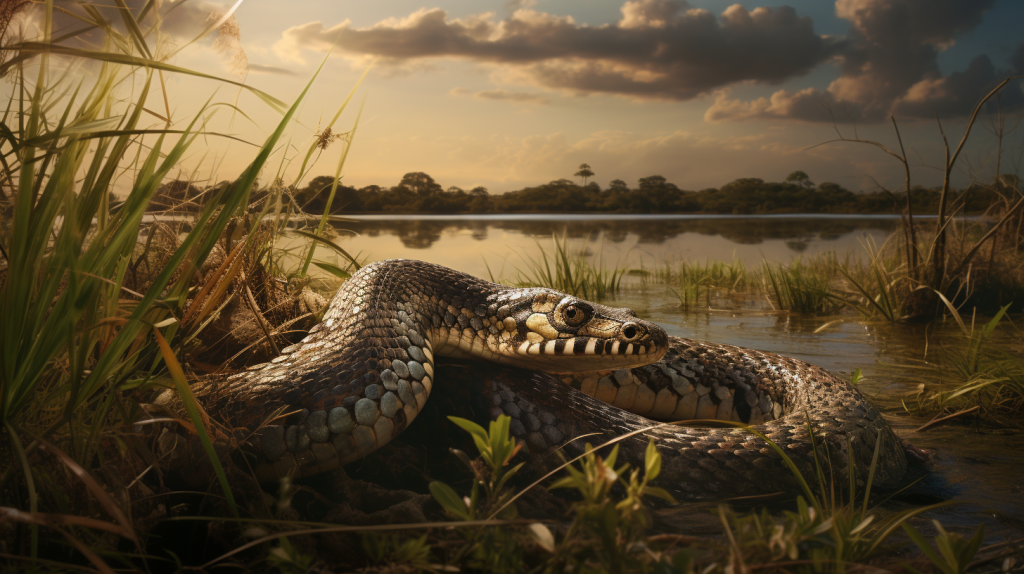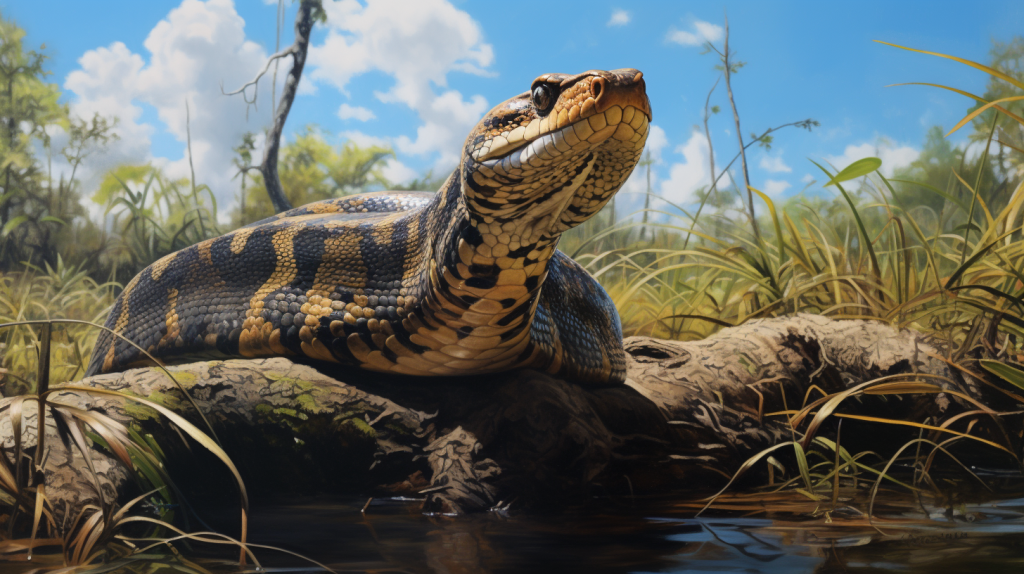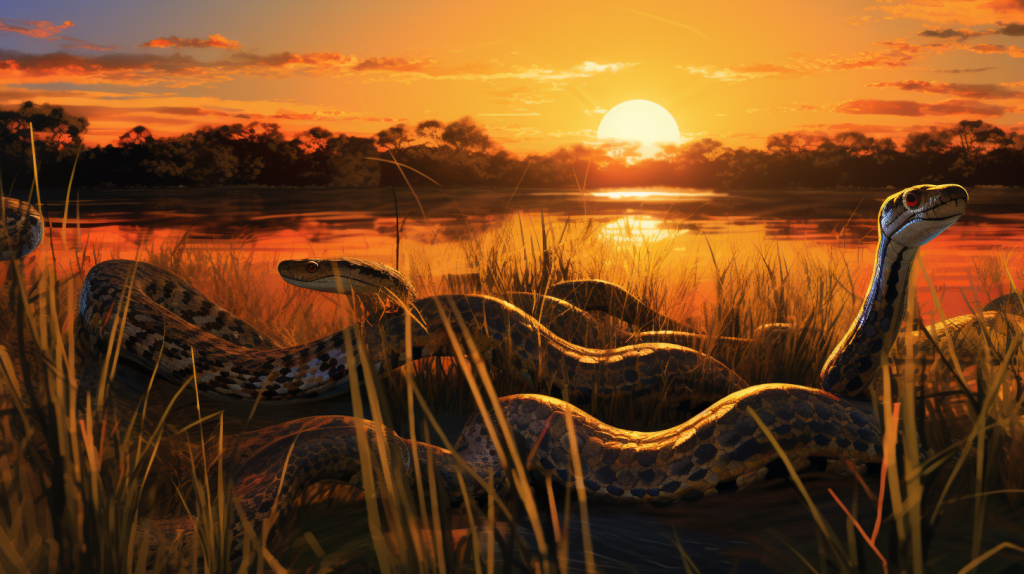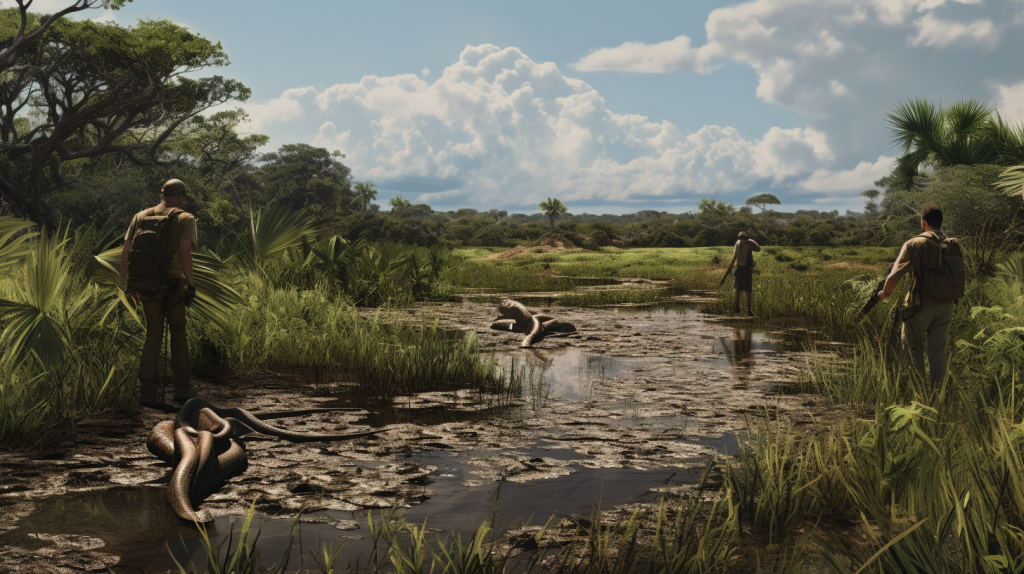Amidst the enchanting landscapes, the big snakes in Florida are a worrying trend. For those whoever felt the pulse of nature beneath their feet as they explore the wild heart of Florida, understand this issue at hand. Concerns however emerge as the surge of these big snakes create a major problem for residents and animals alike.
From the dense swamps to urban neighborhoods, these serpents are weaving a story that captures our attention. Let’s dive into the complex nature of this trend, exploring the implications it holds and the efforts to counter its impact.
Burmese Python: Invader Extraordinaire
Imagine a canvas painted with the vibrant hues of Florida’s native flora and the symphony of calls from indigenous birds. Now, let your imagination conjure an awe-inspiring sight – a colossal serpent gracefully slithering through this serene scene.
Behold the Burmese python, an invader extraordinaire that has burst forth into the Sunshine State, seizing attention and sparking curiosity. This captivating spectacle takes center stage as these serpents boldly adapt to their newfound habitat, embracing the challenges of their environment and multiplying with astonishing speed.
Originally introduced as exotic pets, these pythons have embarked on a remarkable journey, transitioning from captive companions to becoming apex predators in the wild. Their saga is nothing short of remarkable, weaving together a narrative of adaptation, survival, and the intricate dance between species in Florida’s ever-evolving ecosystems.
African Rock Python: In the Shadows
As you venture deeper into Florida’s wild expanse, another enigmatic presence comes to the fore – the African Rock Python. With an air of mystery, these serpents burst onto the scene, embodying stealth, power, and an uncanny sense of survival.
Renowned for their strength and cunning, African Rock Pythons are compelling figures amidst the state’s diverse landscapes. As they navigate the intricate web of Florida’s ecosystems, a tapestry of challenges and opportunities unfolds.
Their presence poses complex problems, as they intricately carve their place amidst native wildlife, adding layers of intrigue to the region’s natural dynamics. Bursting forth with activity, they offer glimpses of a predator’s prowess, while simultaneously shedding light on the intricate complexities of coexistence between invasive and native species.
Boa Constrictor: A Silent Intruder
In the ever-evolving narrative of Florida’s wildlife, the stage welcomes another intriguing character – the Boa Constrictor. With an entrancing blend of colors and patterns, these serpents burst onto the scene, hailing from the distant realms of Central and South America.
As they traverse the borders between continents, they bring with them a burst of diversity and unique dynamics, casting their presence across Florida’s diverse landscape. Their hunting techniques, a testament to their silent prowess, are nothing short of fascinating.
These constrictors employ a methodical precision, wrapping their muscular bodies around prey, embodying a balance of power and control. Yet, with their cryptic ways come inherent dangers, as the boa’s presence raises intricate questions about its interactions with other invasive and native species. Their role in the ecological puzzle adds depth and complexity to the intricate tapestry of Florida’s wilderness, challenging our understanding of the interactions that shape its vibrant ecosystems.
Eastern Diamondback Rattlesnake: Native and Yet Complex
Amidst the narrative of invasions and introductions, a native guardian stands firm – the Eastern Diamondback Rattlesnake. With an aura of mystique, these serpents burst forth as both a symbol of Florida’s native heritage and a testament to its complexity.
Their presence weaves an intricate tapestry in the state’s ecosystems, playing a role that extends beyond the superficial layers of the landscape. Challenges emerge as we delve into the intricacies of balance between native species and the impacts of invasive newcomers.
The Eastern Diamondback Rattlesnake’s presence is a reminder of the delicate equilibrium that governs nature’s theater, and their distinctive rattling warning echoes as a metaphor for the nuanced symphony of interactions within the wild. As we navigate these complexities, we are invited to explore the depths of coexistence and to understand the intricate threads that bind Florida’s native and invasive inhabitants.
Implications for Ecosystems: A Burst of Imbalance
Beyond the realm of individual species, the implications of the big snake trend cascade across ecosystems, leaving a wake of disruption and imbalance in their path. These serpents, with their voracious appetites and unchecked predation, cast ripples of disarray throughout the delicate tapestry of life.
The intricate web, woven over millennia, unravels as these invaders prey upon the very threads that sustain it – birds, mammals, and reptiles alike. In their burst through the established order, they lay bare the fragility of nature’s intricate connections, exposing the vulnerabilities that lie beneath the surface.
The challenge of restoring equilibrium takes on new dimensions as we grapple with the daunting task of reweaving the threads that have been unravelled, navigating a landscape forever transformed by their presence.
Human Response: Bursting into Action
Amidst the intricate tapestry of this narrative, humans are stepping onto the stage with a burst of determination. Conservationists, researchers, and wildlife agencies converge, driven by a shared mission to stem the tide of big snakes in Florida.
Bursting forth with a collective resolve, they wield removal programs and research initiatives as their weapons, diving headfirst into the heart of the wild’s challenges. Their efforts ripple across the landscape, a burst of hope that echoes through the swamps and woodlands.
As they strive to restore equilibrium, they recognize that the key lies in awareness. With public awareness campaigns taking center stage, communities are empowered to become active participants in this story of conservation. By identifying and reporting snake sightings, they add a vital layer of vigilance, an extra burst of eyes and ears attuned to the presence of these serpentine invaders.
Bursting Hope: Towards Restoration
With each python captured and every study conducted, the narrative of this complex struggle undergoes a transformation. Bursting with unwavering determination, conservationists stand at the forefront, armed with the resolve to mend what has been disrupted.
Their tireless efforts, a testament to human ingenuity and commitment, form a bridge towards restoring the equilibrium that Florida’s landscapes once knew. Amidst this dynamic dance, the Everglades stands as an emblem of the state’s natural diversity, a living testament to the power of resilience and rejuvenation.
In its sprawling expanse, bursts of life rekindle, reminding us that the bursts of effort we invest can lead to bursts of restoration, a symphony of hope that resonates through the heart of the wild.
Conclusion: Big Snakes In Florida
In the grand tapestry of these big snakes in Florida add bursts of complexity and adaptation. Resilience defines their role – from invaders to native species. As we navigate this dynamic trend, let’s remember the bursts of human effort and the bursts of hope that guide us in preserving the intricate balance of nature.
FAQs: Unraveling the Mysteries
Q: Why are big snakes a concerning trend in Florida?
Big snakes in Florida, such as the Burmese Python and African Rock Python, are concerning due to their invasive nature. They disrupt native ecosystems, prey on native wildlife, and upset the natural balance.
Q: Which big snake species are invading Florida?
Several big snake species have invaded Florida, including the Burmese Python, African Rock Python, Boa Constrictor, and the native Eastern Diamondback Rattlesnake.
Q: How do big snakes impact native wildlife and ecosystems?
Big snakes disrupt ecosystems by preying on birds, mammals, and reptiles. This leads to imbalances in the food chain and threatens the survival of native species.
Q: What measures are being taken to address the big snake invasion?
Conservationists and wildlife agencies are actively involved in python removal programs, research initiatives, and public awareness campaigns to combat the rise of big snakes in Florida.
Q: Is restoration possible amidst the complexities of this trend?
Restoration efforts are ongoing, with a focus on capturing and removing invasive snakes, studying their impact, and educating the public. While challenges remain, bursts of hope arise as humans strive to restore the balance of Florida’s ecosystems.
References:
- Everglades National Park. (n.d.). Burmese Python – Python bivittatus. https://www.nps.gov/ever/learn/nature/burmesepython.htm
- Florida Fish and Wildlife Conservation Commission. (2022). Python Removal Program. https://myfwc.com/wildlifehabitats/nonnatives/reptiles/burmese-python/removal-program/
- National Park Service. (n.d.). African Rock Python. https://www.nps.gov/ever/learn/nature/african-rock-python.htm
- University of Florida IFAS Extension. (2021). Boa Constrictor. https://edis.ifas.ufl.edu/uw482
- Florida Museum. (n.d.). Eastern Diamondback Rattlesnake. https://www.floridamuseum.ufl.edu/herpetology/fl-snakes/list/crotalus-adamanteus/





